|
|
| Übersicht – Contents: | |
|
|
| Übersicht – Contents: | |
Flaggen – Flags: |
|
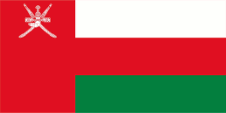 |
seit/since 1995, National- und Handelsflagge – national and merchant flag, Seitenverhältnis – ratio = 1:2, Quelle/Source, nach/by: Flags of the World, using commons.wikimedia.org |
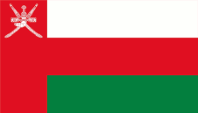 |
seit/since 1995, Staatsflagge – state flag, Seitenverhältnis – ratio = 4:7, Quelle/Source, nach/by: Flags of the World, using commons.wikimedia.org   |
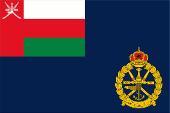 |
seit/since 1995(?), Marineflagge – naval flag, Seitenverhältnis – ratio = 2:3, Quelle/Source, nach/by: Flags of the World, using commons.wikimedia.org |
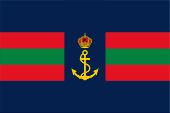 |
seit/since 1995(?), Gösch – naval jack, Seitenverhältnis – ratio = 2:3, Quelle/Source, nach/by: Flags of the World, using commons.wikimedia.org |
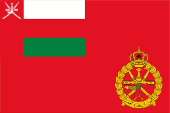 |
seit/since 1995(?), Flagge des Heeres – flag of the Army, Seitenverhältnis – ratio = 2:3, Quelle/Source, nach/by: Wikipedia (EN), using commons.wikimedia.org |
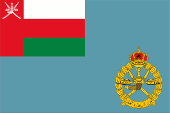 |
seit/since 1995(?), Flagge der Luftwaffe – flag of the Air Force, Seitenverhältnis – ratio = 2:3, Quelle/Source, nach/by: Wikipedia (EN), using commons.wikimedia.org |
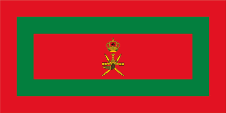 |
seit/since 1995(?), Königliche Flagge (Flagge des Sultans) – royal flag (flag of the Sultan), Seitenverhältnis – ratio = 1:2, Quelle/Source, nach/by: Flags of the World, using commons.wikimedia.org |
historische Flaggen – historical Flags: |
|
 |
1913–1954, Flagge des Imamats Oman – flag of the Imamate of Oman, Quelle/Source, nach/by: Wikipedia (EN) |
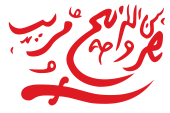 |
1954–1957, Flagge des Imamats Oman – flag of the Imamate of Oman, Quelle/Source, nach/by: Wikipedia (EN), BlinxTheKitty, Public domain, via Wikimedia Commons |
 |
1856–1970, Flagge des Sultanats Maskat und Oman – flag of the Sultanate of Masquat and Oman, Quelle/Source, nach/by: Wikipedia (EN) |
 |
1970–1995, National- und Handelsflagge von Oman – national and merchant flag of Oman, Seitenverhältnis – ratio = 2:3, Quelle/Source, nach/by: Wikipedia (EN), using commons.wikimedia.org |
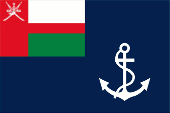 |
1970–1995, Marineflagge von Oman – naval flag of Oman, Seitenverhältnis – ratio = 2:3, Quelle/Source, nach/by: Flags of the World, Flaggen und Wappen |
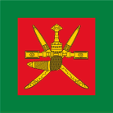 |
bis/to 1995, zweifelhaft – doubtful, Flagge des Sultans von Oman – flag of the Sultan of Oman, Quelle/Source, nach/by: unbekannt/unknown, using commons.wikimedia.org |
| Die heutige Flagge Omans wurde in ihren Grundzügen am 17.12.1970 offiziell eingeführt, und in den Jahren 1985 (Änderungen am Emblem) und 1995 (Verbreiterung des roten Mittelstreifens) leicht abgeändert. Sie besteht aus drei waagerechten Streifen in Weiß, Rot und Grün, und einem ein Drittel breiten senkrechten roten Streifen am Mast. Im Obereck, im senkrechten roten Streifen, das Staatsemblem (Emblem der Saidi-Dynastie) in Weiß. Bis 1970 war die Flagge einfarbig rot. Rot ist die Farbe der charidschitischen Mohammedaner. Seit 1970 trägt die Flagge den weißen und den grünen Streifen, als Symbolfarben von Frieden und Fruchtbarkeit. In einer anderen Interpretation steht das weiße Feld auch für das Imamat Oman, welches zwischen 1913 und 1957 bestand. Das Grün soll auch für die fruchtbare Provinz Dhofar im Süden des Landes stehen, bzw. auch für den Dschebel Akhdar, ein grünes, fruchtbares Gebirge im Norden des Landes. Das Rot soll auch an die siegreichen Kämpfe des Landes in der Vergangenheit erinnern. Im Jahre 1995 wurde wahrscheinlich nicht nur die Nationalflagge überarbeitet, es wurden in diesem Jahr wahrscheinlich auch neue Flaggen für die Teilstreitkräfte eingeführt, eine Kriegsschiffsgösch und wahrscheinlich auch eine neue persönliche Standarte für den Sultan. Die Farben Rot und Grün scheinen nicht besonders spezifiziert oder genau festgelegt zu sein. | The
today’s flag of Oman was officially introduced on the 17th of December in
1970 in its basic pattern and it was changed a little bit in the year 1985
(change in the emblem) and in 1995 (widening of the red middle stripe) It
consists of three horizontal stripes in white, red and green, and an one
third broad vertical red stripe on the pole. Within the vertical red stripe
in the upper staff quadrant is placed the emblem of the state (emblem of the
Saidi dynasty) in white. Until 1970 the flag was single-coloured red. Red is the colour of the Kharidshitic Mohammedans. Since 1970 the flag carrys the white und the green stripe as symbolic colours for peace and fruitfulness. In an other interpretation the white field stands even for the Imamate of Oman which existed beween the years 1913 and 1957. The green should furthermore represent the fruitful province of Dhofar in the south of the country, respectively also for Jabal Akhdar, green and fruitful mountains in the north of the country. The red is also meant to remind us of the country's victorious struggles in the past. In 1995, not only was the national flag probably revised, new flags for the branches of the armed forces were probably introduced in that year, a warship naval jack and probably also a new personal standard for the Sultan. The colours red and green do not seem to be particularly specified or well defined. |
| Quelle/Source: Die Welt der Flaggen, Flaggen Wappen Hymnen, Wikipedia (EN) | |
Wappen – Coat of Arms: |
|
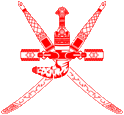 |
Wappen von Oman – coat of arms of Oman, Quelle/Source: Corel Draw 4 |
| Das Staatsemblem des Oman zeigt einen Khanjar (arabischer Dolch mit gebogener Scheide) vor zwei gekreuzten Krummschwertern, belegt mit einem Wehrgehänge. Dieses Symbol findet sich seit 1940 auf Münzen, seit 1966 auch auf Briefmarken des Sultanats Oman. Es ist das Abzeichen der Abu Saids, der omanischen Herrscherfamilie. | The
emblem of Oman shows a Khanjar (Arabian dagger with bended sheath) in front
of two crossed curved swords, covered with an arms-belt.
That symbol is in use on coins since 1940 and since 1966 also on stamps of
the Sultanate of Oman. It is the insignia of the Abu Said family, the Omani
sovereign dynasty. |
| Quelle/Source: Flaggen Wappen Hymnen, Wikipedia (EN) | |
Flugzeugkokarde – aircraft roundel: |
|
 |
seit/since 1985, Flugzeugkokarde – aircraft roundel Quelle/Source, nach/by: Wikipedia (EN) |
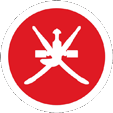 |
1970–1985, Flugzeugkokarde – aircraft roundel Quelle/Source, nach/by: Wikipedia (EN) |
| Landkarte – Map: |
Lage – Position: |
Landkarte des Landes – Map of the Country: |
| Zahlen und Fakten – Numbers and Facts: | |
|
|
|
|
|
|
|
|
|
|
|
|
|
|
|
|
|
|
| 2700–2000
v.Chr. · Umm-an-Nahr-Kultur, Land Makan im Norden heutigen Oman 1800 v.Chr. · Niedergang der Umm-an-Nahr-Kultur 500 v.Chr. · persische Eroberung 2. Jhd. n.Chr. · Einwanderung des Stammes der Azd aus Jemen, Gründung des Reiches der Azd unter der Julanda-Dynastie ab 643 n.Chr. · Islamisierung 7.–8. Jhd. n.Chr. · Niedergang des Reiches der Azd, Unterwerfung durch die Perser des Sassanidenreiches, im 8. Jhd. Ausbreitung der Lehre der Charidschiten 751 · Wahl des ersten Imams (Führer) der Charidschiten 8.–10. Jhd. · Blütezeit als Handelsdrehscheibe 1065–1140 · Invasion der Seldschuken 1256 · Eroberung duch persische Truppen 1507 · Landung der Portugiesen, Eroberung von Maskat, Sur und Sohar 1650 · Abzug der Portugiesen, allmähliche Ausbreitung des Reiches Oman entlang der afrikanischen Ostküste nach Süden 1720–1746 · Erbfolgekrieg 1746 (auch 1741? oder 1744?) · Machtübernahme durch die bis heute regierenden Sultane der Said-Dynastie ca. 1800 bis 1850 · Verlagerung des wirtschaftlichen Schwerpunktes nach Sansibar 1824 · Verlagerung der Residenz des Sultans nach Sansibar 1829 · das Land Dhofar wird von Oman abhängig 1856 · Tod des Sultans, in Folge britischem Drucks Teilung des Landes (Teilung der Dynastie in zwei Linien) in das Sultanat Oman und das Sultanat Sansibar, wirtschaftlicher Niedergang Omans 1879 · das Land Dhofar wird von Oman annektiert 1885–1886 · Aufstand in Dhofar 1891 · das Sultanat Oman wird britisches Protektorat 1891–1913 · weiterer wirtschaftlicher Niedergang, Isolationspolitik der Sultane 1913 · Wahl eines Imam (Salim Ibn Rashid al-Kharusi) durch enttäuschte Charidschiten (Ibaditen), Proklamation des Imamats Oman mit der Hauptstadt Nizwa, Bürgerkrieg 1920 · Tod von Imam Salim Ibn Rashid al-Kharusi, Friedensvertrag zwischen seinem Nachfolger Abd Allah al-Khalili al-Kharusi und dem Sultan von Oman, das Sultanat Oman wird faktisch geteilt und nennt sich nun Sultanat Maskat und Oman (Maskat ist der Sitz des Sultans von Oman, Nizwa ist der Sitz des Imams von Oman) 1954 · Tod des Imams Abd Allah al-Khalili al-Kharusi, Wahl des Ghalib Ibn Ali al-Hinawi zum neuen Imam, das Imamat versucht nun mit Unterstützung von Ägypten und Saudi-Arabien die völlige Unabhängigkeit zu erreichen, Bürgerkrieg 1957 · Eroberung von Nizwa durch omanische und britische Truppen, Sturz des Imams Abd Allah al-Khalili al-Kharusi 1959 · Kapitulation der letzten Truppen des Imamats Oman, Rückbenennung des Landes von "Sultanat Maskat und Oman" in "Sultanat Oman" 1962 · Erste Ölfunde 09.06.1965 · Beginn des bewaffneten Kampfes der Dhofar Liberation Front (DLF) März 1975 · die Dhofar-Rebellen schließen einen Friedensvertrag mit Oman 1979 · erneute Kämpfe in Dhofar 1991 · Ernennung eines Konsultativrats November 1996 · erste Verfassung 1997 · Frauenwahlrecht 1998 · Oman beschließt militärische Zusammenarbeit mit dem Iran Mai 1999 · Grenzvertrag mit den Vereinigten Arabischen Emiraten |
| Quellen: 1.) DB Sonderband: Wikipedia - Frühjahr 2005, 2.) World Statesmen, 3.) Wikipedia (DE) |
| 2700–2000
B.C. · culture of Umm-an-Nahr, State of Makan in the north of the today’s
Oman 1800 B.C. · decline of the Umm-an-Nahr Culture 500 B.C. · Persian conquest 2nd cent. A.D. · immigration of the Azd-tribe from Yemen, foundation of the Empire of the Azd under the dynasty of Yulanda since 643 A.D. · Islamization 7th–8th cent. A.D. · decline of the Empire of the Azd, subjection by the Persians of the Sassanide-Empire, in the 8th cent. propagation of the tenets of the Kharidshites 751 · election of the first Imam (leader) of the Kharidshites 8th–10th century · flowering period as turntable of trade 1065–1140 · invasion of the Seljuks 1256 · conquest by Persian troops 1507 · debarkation of the Portugese, conquest of Maskat, Sur and Sohar 1650 · withdrawal of the Portugese, gradual expansion of the Oman Empire along the African eastern coast in southern direction 1720–1746 · war of succession 1746 (even 1741? or 1744?) · seizure of power by the until today reigning Sultanes of the Said-dynasty ca. 1800 to 1850 · shifting of the economical emphasis to Zanzibar 1824 · shifting of the residency of the Sultan to Zanzibar 1829 · the Country of Dhofar becomes dependent from Oman 1856 · death of the Sultan, in result of British pressure division of the country (division of the dynasty in two lines) in the Sultanate of Oman and the Sultanate of Zanzibar, economical decline of Oman 1879 · the Country of Dhofar becomes annexed by Oman 1885–1886 · rebellion in Dhofar 1891 · the Sultanate of Oman becomes a British protectorate 1891–1913 · further economical decline, policy of isolation exercised by the Sultans 1913 · election of an Imam (Salim Ibn Rashid al-Kharusi) by disappointed Kharijites (Ibadits), proclamation of the Imamate of Oman with the capital Nizwa, civil war 1920 · death of Imam Salim Ibn Rashid al-Kharusi, peace-treaty between his successor Abd Allah al-Khalili al-Kharusi and the Sultan of Oman, the Sultanate of Oman becomes de facto divided and names itself from then on Sultanate of Masquat and Oman (Masquat is the seat of the Sultan of Oman, Nizwa is the seat of the Imam of Oman) 1954 · death of Imam Abd Allah al-Khalili al-Kharusi, election of Ghalib Ibn Ali al-Hinawi to the new Imam, the Imamate attempts now – with support by Egypt and Saudi-Arabia – to achieve the full independence, civil war 1957 · conquest of Nizwa by Omani and British troops, overthrow of the Imam Abd Allah al-Khalili al-Kharusi 1959 · capitulation of the last troops of the Imamate of Oman, re-naming of the country from "Sultanate of Masquat and Oman" in "Sultanate of Oman" 1962 · first findings of oil 9th of June 1965 · onset of the armed struggle of the Dhofar Liberation Front (DLF) March 1975 · the Dhofar rebels come to an agreement of peace with Oman 1979 · once more conflicts in Dhofar 1991 · nomination of a consultive counsel November 1996 · first constitution 1997 · suffrage for women 1998 · Oman starts military cooperation with Iran May 1999 · frontier contract with the United Arab Emirates |
| Sources: 1st) DB special edition: Wikipedia - spring 2005, 2nd) World Statesmen, 3rd) Wikipedia (DE) |
| Der Name des Landes wurde schon als "Omana" bei Plinius dem Älteren erwähnt und auch Ptolemäus erwähnt ein "Omanon". Der Name lässt sich auch aus dem Arabischen ableiten, aus dem Wort "aamen" oder "amoun", was eine sesshafte Bevölkerung bezeichnet. Auch gibt es Namen von historischen Persönlichkeiten, die als mythische Gründer herangezogen werden: Oman bin Ibrahim al-Khalil, Oman bin Siba' bin Yaghthan bin Ibrahim, Oman bin Qahtan. |
The name of the country
was already mentioned as "Omana" by Pliny the Elder and Ptolemy also
mentions an "Omanon". The name can also be derived from Arabic, from the word "aamen" or "amoun", which denotes a sedentary population. There are also names of historical figures who are invoked as mythical founders: Oman bin Ibrahim al-Khalil, Oman bin Siba' bin Yaghthan bin Ibrahim, Oman bin Qahtan. |
| Quelle/Source: Wikipedia (EN) | |
Imamat Oman |
|
|
|
 |
1913–1954, |
 |
1954–1957, Flagge des Imamats Oman – flag of the Imamate of Oman, Quelle/Source, nach/by: Wikipedia (EN), BlinxTheKitty, Public domain, via Wikimedia Commons |
| Das
Sultanat Oman war seit 1913 zweigeteilt. In Maskat residierte der Sultan und
in Nizwa seit 1913 der Imam von Oman. Das Imamat Oman unterstand nur formal
dem Sultan von Maskat und wollte sich 1954 von Großbritannien und Maskat
lösen und die Unabhängigkeit erreichen. Nach einem Bürgerkrieg wurde das Imamat 1959 beendet und Maskat einverleibt. Das Imamat Oman verwendete eine einfarbige weiße Flagge. Die Farbe Weiß steht in der islamisch-arabischen Welt für die Dynastie der Omajiaden, eine Kalifendynastie, die auf den fünften Kalifen Moawija I. zurückgeht. |
The Sultanate of Oman was divided since 1913. In Masquat resided the Sultan and in Nizwa since 1913 the Imam of Oman. The Imamate of Oman was only formally subordinated the Sultan of Masquat and attempts in 1954 to untie itself from Great Britain and Masquat and to achieve the independence. After a civil war the Imamate was terminated and in 1959 incorporated to Masquat. The Imamate of Oman used a single-coloured white flag. The colour Farbe white stands in the Islamic-Arabian world for the dynasty of the Omajiades, a dynasty of Califs which has its roots in the fifth Calif Moawija I. |
Dhofar |
|
|
|
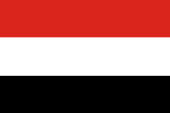 |
1965–1975, Nationalflagge von Dhofar – national flag of Dhofar, Quelle/Source, nach/by: World Statesmen  |
| Der an Jemen grenzende Landesteil Dhofar (Zufar, Dhufar) war erst 1879 vom Sultanat Oman annektiert worden. Gegen die omanische Herrschaft gab es immer wieder Aufstände. Im Jahre 1964 brach dann ein offener Bürgerkrieg aus. Bis 1970 war das ganze Land in der Hand der Separatisten und 1971 wurde eine eigene Regierung eingerichtet. Südjemen leistete massive Unterstützung. Bis 1975 konnte sich Dhofar halten. Nach dem Waffenstillstand vom März 1975 wurde der bewaffnete Kampf fast ganz aufgegeben. Dhofar verwendete eine Flagge, die derjenigen der Nationalen Befreiungsfront im Südjemen sehr stark ähnelte. Zeitweise wurden die Farben auch umgedreht oder arabische Schiftzeichen im weißen Streifen eingefügt. |
The to Yemen bordering Countryside of Dhofar (Zufar, Dhufar) was annexed by the Sultanate of
Oman not until 1879. There were again and again riotings against the Omani
reign. In the year 1964 broke out then an open civil war. Until 1970 was the whole country in the hand of separatists and in 1971 was established an own government. South Yemen gave massive support. Dhofar was able to withstand until 1975. After the armistice of March 1975 was given up the armed struggle nearly complete. Dhofar used a flag which was resembling the flag of the National Liberation Front in South Yemen. Sometimes the colours became upturned or Arabian signs were added in the white stripe. |